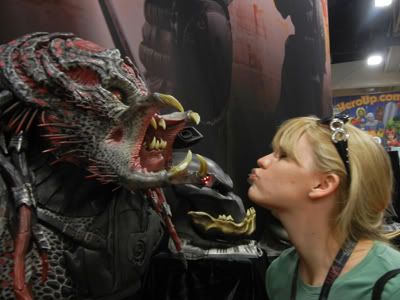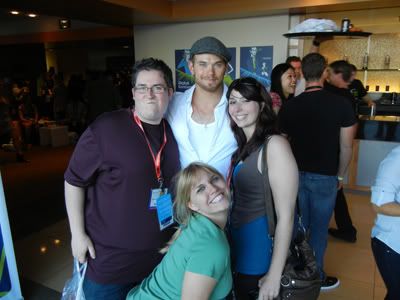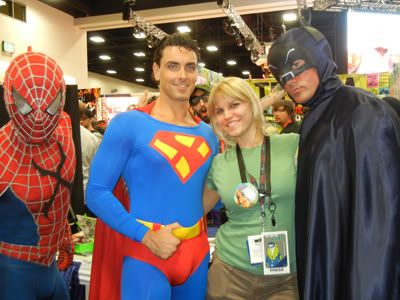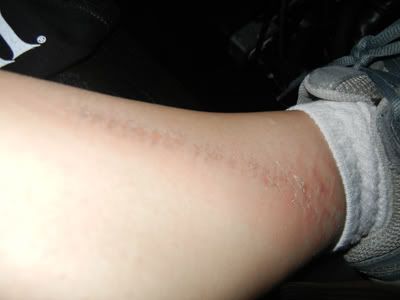After a full day of waltzing around in heels—either as Black Canary or Comic Con Party Goer #317—I decided it might be best to wear sneakers. I decided to braid my hair and wear brown shorts with a green t-shirt at scour Comic Con as “Not Lara Croft.” A few people got it, but for the most part I was left unbothered, which is fine by me. I only really wanted one person to call me out on it and he did. I must say, wearing sneakers and roaming around on foot still hurts after a day of heels, but it hurts “so good,” in a way.
Anyway, Lea, being a fan of the Locke and Key comics, took me upstairs to see the panel for the failed pilot of the show of the same name. We missed the screening of the pilot episode, but we made it into the panel to listen to Joe Hill, director Mark Romanek, pilot-writer Josh Friedman and a few of the actors. I wasn’t exactly aware of the project prior to coming to Comic Con and checking out the schedule, so I wasn’t entirely invested but it was an exciting panel. I took copious amounts of notes on a Starbucks napkin and will likely write up a little article about the panel. I am currently trying to get a hold of the pilot, so I can write an accompanying review, but we’ll see what happens.
After the panel, Lea and I stalked around the convention floor again. We looked at all the awesome reproductions and scale models of all-things nerdy from Sideshow Showcase, I even found my new boyfriend!

Another thing that was there, that I did not get a picture of, was a lifesize reproduction of the T-800 in the original Terminator, after it had been stripped of its Arnold skin and was all metal and porcelain teeth. While gazing at its magnificence, I overhear someone commenting on it:
“Why would they make the teeth porcelain when the rest of it is metal?”
Trying my best not to punch anyone in the face, I reply, “Because it used to look human.” Duh. Apparently the Con-goer didn’t hear me because I never got a response, but a third party did. He turned away from the statue and gave me a nod as we shared a look of “how stupid can someone be?” I mean, there is a possibility that this guy had never seen Terminator, in which case, where has he been in the last 20 years. Even if he hasn’t seen it, he must surely know what one is due to the collective pop culture consciousness that we share. But in all likelihood he probably has seen it, and his inability to recall certain elements of the franchise is pretty mindboggling.
Also on the floor, I purchased my only souvenir from Con (I had a few other free ones, some of which are pretty cool). And that is a red shirt dress from Star Trek TOS, officially licensed by Roddenberry. Remember this, as it will come back up.
Shortly thereafter, we picked up Ben Dunn, Lea’s brother, and went up to interview the kind people of Thundercats. I interviewed Emmanuelle Chriqui (Sloane of Entourage) who is the new Cheetara, Ethan Spaulding, a producer of the show, and the original voice of Lion-O Larry Kenney, who will voice Lion-O father, Claudus, this time around. The interviews hardly went without a hitch. Ms. Chriqui didn’t feel like looking at the camera and was timid to give out much information; I went blank while interviewing Mr. Spaulding—hopefully my good friends here will edit that out—and the one awesome interview that I did, well, we ran out of battery. So, I think we have maybe 30 seconds of my interview with Larry Kenney, who is a very charismatic and awesome human being.
Afterward, we headed over to the Wired Café for some free booze and food. Oh, the perks of being in the press. While it was awesome to get free things, I must admit that the booth babes working the Fangtasia bar were perhaps some of the most incompetent people I can imagine. It seriously took one of them 45 seconds to open two cans of pineapple juice. I suspect these girls are working for tips, in addition to whatever HBO feels like coughing out, so their lack of interest astounds me. Seriously. People who are paid to do something and don’t do it with any kind of efficiency baffle me. I don’t care how cute you are or how perky your rack is. I want my Death on the Beach and I want it in a somewhat timely manner. Seriously, it’s not as if she was doing something else. She was just standing there, pineapple juice in hand, not opening it. Vacant staring all around.
And that’s my rant against booth babes. You’re welcome.
Also while at the Wired Café, being awesome, Ben, Lea and I got a picture with Kellan Lutz. I didn’t know who he was, but I’m in the photo anyway. For those of you still uncertain of who this filet of manliness is, he’s Emmett from the Twilight saga and will be Poseidon (“god of wetness … and moisture”) in the upcoming Immortals flick (more on that in part 3!).

Look how Ben ruins an otherwise breathtaking photo.
When we finished up here, we scampered (yeah, we can do that) back to the Geekscape booth where our good pornstar buddies are signing autographs and giving away SFW porn (it apparently exists?). Since I was about to leave to do an interview with the real Batman (Mr. Adam West), I took a shot with the guys and headed out.

Seriously, though. Look at Superman. He could repopulate Krypton with that thing. Or at least the Bottle City of Kandor.
I originally believed that I was going to be on-camera for this interview, but things did not turn out to be so. Instead, it was a round-table interview—six or so different interviewers get together and shoot questions at the interviewee and hope to get some decent info—which is fine, of course, but I don’t think the video I took is any good, so I will likely have to just turn it into an article of awesomeness. Anyway, the interviews were with Adam West, Burt Ward and Julie Newmar, promoting or commemorating the 45th anniversary of the original TV series.
Now while it was cool to meet the original Batman and Robin, I must admit that I only cared about in my fangirl heart of hearts to meet Julie Newmar. For a number of reasons. The first, Catwoman has always been one of my favorite characters. I had dressed up for her for Halloween more times than I can say, each time a different version (from the Burton film to the comics to even the cartoon). Also, she—Ms. Newmar—is my favorite Catwoman and my original idol. That is, she, as Catwoman, was who I wanted to emulate and be when I grow up. She’s beautiful, brilliant and quite the entertainer. Who wouldn’t want to be compared to her?
So, imagine my delight when I sit next to her (right next to her. Because, I mean, I had to) and she turns to me and tells me I am “adorable.” Now, I know, you don’t usually get flattered by someone calling you adorable, but this is Julie-freaking-Newmar. Essentially the only person at Con that I met and was completely star-struck by. Her calling me anything, especially on the positive side like “adorable”, was just … gah. I can close my eyes forever now and be pretty happy. True story. Sadly, since this was a “professional” situation, I wasn’t able to get a picture with her, but I do have recording of our voices together and that is pretty stellar.
Adam West really only wanted to pimp out his new comic book, which is fair. Though his obviously rehearsed “My life has come full circle. I played a comic book character on TV and now I am one!” lost its shine after the third announcement. Still, cool to meet a Batman. Burt Ward was perhaps the most ridiculous (not to say Newmar and West weren’t, they definitely had their eccentricities). After the round table was over, he kept us at the table for an addition ten minutes to tell us about his new show (which has yet to be picked up by a network) about the 50 dogs he lives with in his home, which doubles as an animal shelter. He showed us a picture of one “puppy”—a seven foot tall great dane—and a camel, that apparently is the pet of one of his neighbors. I was talking to a friend of mine the other day about this, she apparently knew it existed (Burt Ward’s animal shelter, I mean), and said it was rather nefarious, since he doesn’t neuter all of his dogs and claims that none of them don’t get along. I wonder if any of this will come up if the show gets picked up. Should be interesting.
After the interviews, I headed over to the El Shaddai party. Free booze and hors d’oeuvres. I was probably more excited about the food than the drink, but it was all a recipe for disaster. When to came in, they gave you a raffle ticket, which I packed into my purse and left at a booth with some friends while I went to get a drink. Since it was a full bar, I decided I wanted to get something fun, so I ordered a raspberry martini and hung around the bar, chatting with whoever was available. While I was drinking my martini, Gilmore comes up to me and demands to try it. Finding it satisfying, he orders one for himself while I pick up my second. While at the bar, the raffle begins. I don’t have my ticket on me, but I remember my number, so while I’m in the middle of conversing with someone about the raffle and the names of things (El Shaddai means “the breasted one” in Hebrew. It’s a name for God), I hear “Enoch 17” get called. My eyes get wide and I drop my glass (or place it on the bar, you decide) and run over to my bag. I dump it out and fish for my ID case. As they go to pass my number over, I find it and present it and get my prize. I think it’s an art book, but I’m unsure. It’s in Japanese and I have yet to crack it open.
Anyway, after putting everything back in my bag—including my artbook—I go back to the bar where half of the new people I have met over the last two days are … all of them with a raspberry martini. All of them male.
“This is how STDs spread,” I comment, while ordering my next one and picking off cheeseburger spring rolls and Philly cheesesteak dumplings off trays (DELICIOUS, by the way).
Anyway, around 10 or 11 or so, we cut out of there and decide what to do next. We go to another bar to figure things out. Another bar that, for some reason, refused to serve me but happily served Gilmore who was clearly blazed. My theory, because I was still cognizant, is because I changed into my red shirt dress (but kept my sneakers on), and therefore looked moderately ridiculous. Or they just thought a mid-scene dress change was odd. Clearly they’ve never seen the Oscars. We didn’t stick around there for too long, however, as we bopped into a rickshaw (or pedicab, as it was lead by a bike), and headed over to Nerd HQ.
As we arrive, I manage to fall out of the rickshaw and get run over. Yeah, you read that right. I got ran over by a rickshaw. Hilarious. You’re all assholes. Actually, it is pretty funny, despite how much it hurt and muddled up my plans to dress up again as Black Canary on Saturday. Despite being run over, I manage to hop back on to my feet (with some help). A friend of mine, commenting on this as I told him this story, “Of course you did. You’re Molly f’ing Mahan. Nothing will keep you down, no matter how stupid or dangerous.” I’m practically a superhero. Only my archnemesis is clearly my drunk-ass self. Basically, I’m Iron Man and my nemesis is Tony Stark (or Molly Mayhem, if you prefer). Anyway, as everyone is trying to get me up and figure out how this happened, the cabby flees the scene. So no justice for the wicked and inebriated. As I get to my feet, everyone asks me how I am doing, and of course I laugh it off and say that I’m fine and I hobble into the Nerd HQ. We find a booth, and continue the night as planned.


A good reminder not to wear a red shirt while on an away mission
Intermittently, through the evening, I would laugh, crack jokes, and without warning break down and cry. Between the alcohol and my own pain tolerance, the pain would go over and back under the threshold. It was entertaining, I’m sure. And, of course, since I wasn’t with a bunch of doctors, the response to treat this was to get more alcohol to consume and help numb the pain.
There was a photo booth at the event, and of course I took pictures in them, and you can obviously see that I had been crying or was about to in the middle of the shot.
After Nerd HQ the party broke up. I did the responsible thing and dragged Gilmore over to Denny’s. I talked some things over with him, none of which he remembers as he was clearly about to fall asleep, face first, into his eggs-over-my-hammy, but I know I needed to eat something at the very least. When we got back to the hotel, I asked the receptionist for some first aid (see, mom? I am responsible!). She told me she didn’t have any, but called security to bring some.
Security came about five minutes later with 5 small adhesive bandages. Awesome.
When Gilmore and I got back to the room, we saw some fries outside the hotel room. He drunkenly complained about the room service bill, while I took the opportunity to sit down and pick at them. He eventually sat down too.
At least we got a song out of the night. “Molly got run over by a rickshaw, on her way to Nerd HQ last night.” (to the tune of “Grandma Got Runover by a Reindeer”) It haunted the remainder of my Comic Con experience.